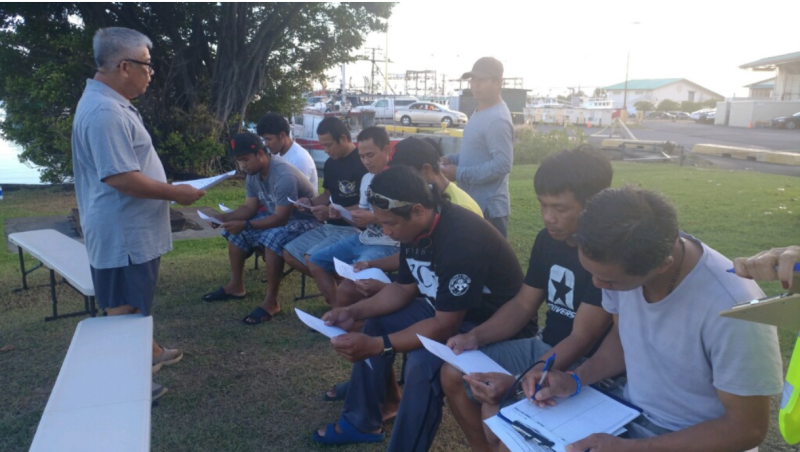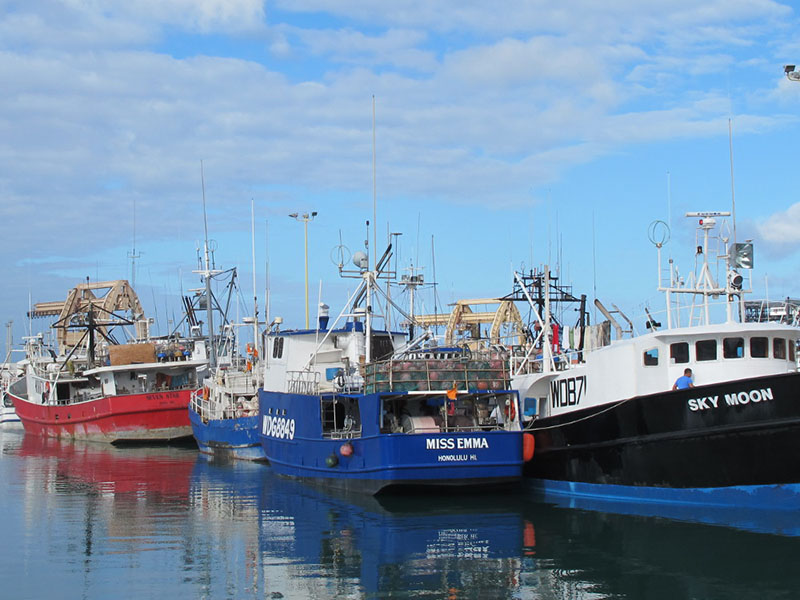After two decades it’s far past time to make it easier for foreign fishermen who work in the Hawaii longline fleet, industry advocates say.
The lockdown after the September 2001 terrorist attacks in New York and Washington, D.C., still reverberates in the U.S. Pacific pelagic fishery, with complicated entry rules and procedures for crew from Indonesia and the Philippines who make up the bulk of the fleet’s workforce.
“Prior to 9/11 our crewmen were allowed to fly into” Honolulu to board the fleet of some 140 longline vessels, said Eric Kingma, executive director of the Hawaii Longline Association.
“So it has been about 20 years now for our fleet not being able to fly our crew in,” he said. “This issue has been around for a while and we need to resolve it.”
During the covid-19 pandemic, the Hawaii fleet has been a vital lifeline for protein to the state’s population even while taking a huge hit in lost revenue. The state’s tourism economy is a scant 25 percent of its usual volume, and between March and July 2020 the longline fleet’s revenue was down 45 percent with the pandemic collapse in restaurant business, said Kingma.
With those jobs lost, fishermen pitched in with 100,000 pounds of ahi and other fish contributed to food banks, for 350,000 servings. Local seafood is vital to Hawaii’s population, diet and culture, with consumption two to three times the U.S. average.
Now is a good time to reconsider those longstanding travel restrictions on foreign fishermen, Kingma says. Hawaii is the nation’s foremost producer of fresh iced tuna and its workforce is as critical as seasonal farm workers on the U.S. mainland, he said.
“You need access to labor, to people willing to do a tough job,” he said. “These workers are integral to the food production system in the U.S.”
The first Hawaii longline fishery was started around 1917 by fishermen from Okinawa who fished seasonally not far from shore, said Kingma. The modern longline fleet of around 140 vessels homeported at Honolulu got its started about 30 years ago – pioneered by experienced swordfish captains from the U.S. East Coast including Skip Gallimore and Dave Ghigliotty from Barnegat Light, N.J.
“Those guys started to come over in the late ‘80s, early ‘90s. They were targeting swordfish, that’s how the fishery got started,” said Kingma. “They went after swordfish up north and had some fantastic trips.”
Their success attracted attention and a number of Vietnamese American fishermen from the Gulf of Mexico came in the early 1990s. From around 30 vessels the fleet expanded to almost 200, until in the mid-1990s the Western Pacific Fishery Management Council put in a limited-entry plan that capped the fishery at 164 permits.
“The fishery changed from being more seasonal to a full year-round operation,” with bigger gear and longer trips, said Kingma. Now about 100 operators hold 140 active permits.
Foreign crew members began entering the fishery in the 1990s, enabled by regulatory changes a few years before. Typically employed for two-year contracts, most workers come from Indonesia and the Philippines, attracted by opportunity to earn around five times what they can fishing at home, said Kingma. Up to 700 crew work in the fleet, although recently it’s experienced a labor shortage that’s kept some vessels from working fully.
Workers could travel directly to and from Honolulu before 9/11. Since then travel has been much more complicated.
“We have to go pick them up in a foreign port,” usually in Canada or Mexico, to transit back to Hawaii for processing and permit approval by U.S. Customs and Border Protection, said Kingma. American Samoa, a U.S. territory that maintains its own immigration authority, had been the favored port of arrival for about 10 years until it was closed for coronavirus precautions.
When in port, crewmen stay around the Pier 38 Fishing Village, under oversight of Customs and Border Protection. In 2016 allegations were raised of poor working conditions, confinement or crewmen and human trafficking. CBP and other authorities found no evidence to bear out those complaints, and the Hawaii Longline Association conducted its own assessment of conditions.
That led to an industry task force and adoption of internal reforms. Operators developed and implemented a standard universal crew contract and crew handbook translated to workers’ languages, that included a guide to crew grievance and points of contact to call with complaints.

A crew grievance committee meets regularly. The association developed an employer’s code of conduct, based on international and domestic fair labor guidance, and implemented standards in the fishery with signed “letters of assurance” from vessel owners, captains, and crew.
In a Feb. 4 statement, the association endorsed recommendations by federal agencies for combating human rights abuses in the international seafood trade. Bringing back temporary worker visas for Hawaii crew could help resolve perceptions that they are treated unfairly, said Kingma.
“I think it’s a lack of understanding of the situation locally,” he said. “The lack of work visas complicates it and people don’t understand the on-the-water reality…it’s difficult for people to understand fishing.”







